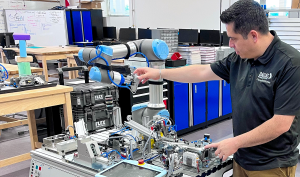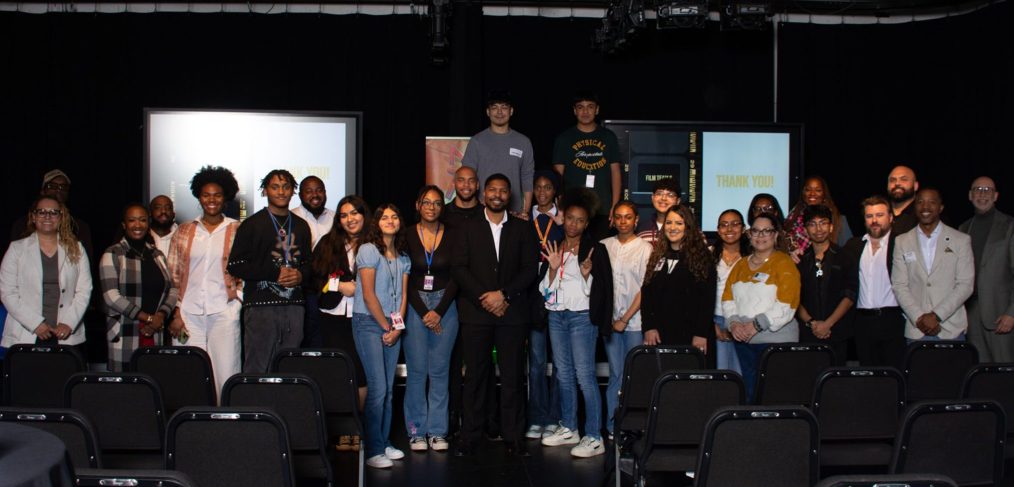When Guillermo Michel began his career as a science teacher, little did he know he would be instrumental in establishing Dallas ISD’s career institutes, which allow students to explore a variety of careers and obtain industry certifications.
Recognizing the need for specialized training, the district launched the career institutes in 2019. Michel, industry partner and program coordinator at Career Institute North, has played a pivotal role in developing the 18 career programs offered across the district. February—Career and Technical Education month—highlights the training and career programs that create internships, industry certifications and credentials for students beyond what their home campuses may offer.
“Not all high schools have comprehensive programs,” Michel said. “The original idea was to create four institutes—one in the north, south, east and west, serving 25 high schools.”
 It was his work in the STEM Department, which he joined seven years after working as a teacher, that led to the career institutes. Michel used skills from his undergraduate background in media and communications to create professional development learning materials in math and science.
It was his work in the STEM Department, which he joined seven years after working as a teacher, that led to the career institutes. Michel used skills from his undergraduate background in media and communications to create professional development learning materials in math and science.
His online training materials were so effective that he was recruited to help launch the career institutes.
Deputy Chief Oswaldo Alvarenga, who previously directed the district’s STEM and CTE departments, saw the value in Michel’s impact and wanted to use his skills beyond just math and science.
Michel was brought on to create promotional materials for counselors, principals, and high school students to inform them about the new development.
From the beginning, the goal of the career institutes has been to prepare students for the workforce by providing industry ready training in high demanding fields such as health sciences, technology, construction and other key professions.
“It has been great to see all of the progress. We started with four teachers in a small office, sending out four teachers to instruct principles of construction and principles of architecture,” Michel said.
Within the past six years the career institutes have evolved into expansive campuses with industry standard technology, devices and tools for students.
“The great thing about CTE is that there is always something new,” Michel said. “There is always a new technological update to add. We keep up with whatever is developing across the world.”
Students enter the program during their freshman year. They begin with introductory courses that eventually lead to interactive labs in their career focus. 
“There are many booming industries, but not a lot of technicians who can do the skilled work,” Michel said. “So that is one of the main goals of the institute, to give the industries qualified manpower to do those jobs.”
A unique but simple aspect of the career institutes is the institute’s focus on developing the student’s soft skills.
“When we spoke with companies and asked them what they needed from our students, they said we just need them to show up on time and pay attention, but if they have industry based certifications already right out of high school, that is amazing!” he said.
The companies recognize that students will have the necessary certifications and skills to succeed and are looking for something more—expectational communication skills. In response, CI North focuses on expanding student’s resumes and developing their social skills.
What Michel finds most impactful is how students not only develop essential career skills but also form meaningful friendships across the four institutes, fostering both professional and social development.
From aviation to game design, to health sciences and construction, Michel has helped create an intricate learning system—where students are building HVAC systems, designing games and using simulators to fly and land private planes.
“Some students come in feeling really shy, unsure of themselves and hesitant to speak up,” Michel said. “But as the years go by, something incredible happens. By junior or senior year, they’ve transformed—standing taller, speaking with confidence, and believing in their potential. The quiet kid who once avoided eye contact is now leading projects and mentoring others. It’s a reminder of why we do what we do. Earning industry certifications gives them more than just credentials—it gives them hope. Hope for a better future, for real opportunities, and for the chance to become leaders. Each certification is proof of their hard work and resilience, opening doors to careers and a future they once only dreamed of.”






 Located on the campus lawn, the statue symbolizes the exceptional talent nurtured at the school and the significant history within the sports community. According to Gillespie, Banks is well known in Chicago and grew up in the neighborhood that once surrounded Booker T. Washington, which he attended in the 1940s before the school became an arts magnet.
Located on the campus lawn, the statue symbolizes the exceptional talent nurtured at the school and the significant history within the sports community. According to Gillespie, Banks is well known in Chicago and grew up in the neighborhood that once surrounded Booker T. Washington, which he attended in the 1940s before the school became an arts magnet. 
 For years, a state-of-the-art film and music facility at New Tech High School at B.F. Darrell sat unused until Trenton Starks brought it to life when he became the school’s film teacher.
For years, a state-of-the-art film and music facility at New Tech High School at B.F. Darrell sat unused until Trenton Starks brought it to life when he became the school’s film teacher. 
 By helping his students succeed in the industry, Starks is also creating representation. According to the UCLA Hollywood diversity report, 6% of writers, directors and producers in the country are African American. Starks said he hopes to change that narrative by teaching his students different ways to tell their own stories. He challenges them to find value in their everyday lives through writing, literature, cinematography or sound design.
By helping his students succeed in the industry, Starks is also creating representation. According to the UCLA Hollywood diversity report, 6% of writers, directors and producers in the country are African American. Starks said he hopes to change that narrative by teaching his students different ways to tell their own stories. He challenges them to find value in their everyday lives through writing, literature, cinematography or sound design. 


